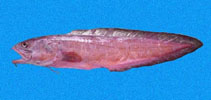| Family: |
Ophidiidae (Cusk-eels), subfamily: Brotulinae |
| Max. size: |
115 cm TL (male/unsexed) |
| Environment: |
benthopelagic; marine; depth range - 650 m |
| Distribution: |
Eastern Central Pacific: Gulf of California to Peru. |
| Diagnosis: |
Dorsal spines (total): 0-0; Dorsal soft rays (total): 108-118; Anal spines: 0-0; Anal soft rays: 78-89; Vertebrae: 55-56. Body completely covered with small, imbricate, cycloid scales; barbels present on snout (6) and chin (6); branchiostegal rays 8; median basibranchial tooth patch absent; developed gill rakers on first arch 4 or fewer; pelvic fin rays inserted at about level of preopercle, well behind eye (Ref. 34024). |
| Biology: |
Adults benthopelagic to 650 m depth, juveniles common on reefs (Ref. 34024). At depths of about 40-75 m, adults are found deep on mud and broken shell bottom (Ref. 36413). Smaller silvery specimens taken far out at sea in the epipelagic (Ref. 34024). Caught occasionally (Ref. 34024). Oviparous, with late post-flexion and transformation stage larvae found in midwater (Ref. 36413). Oval, pelagic eggs float in a gelatinous mass (Ref. 205). |
| IUCN Red List Status: |
Data deficient (DD); Date assessed: 23 May 2007 Ref. (130435)
|
| Threat to humans: |
harmless |
Source and more info: www.fishbase.org. For personal, classroom, and other internal use only. Not for publication.

